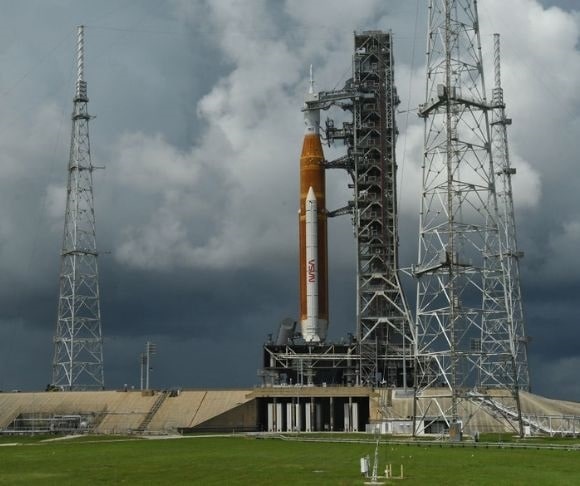
(Photo by Paul Hennessy/Anadolu Agency via Getty Images)
The expectation of billowing rocket motor exhaust and an ear-splitting roar from NASA’s Artemis 1 Space Launch System (SLS) that would have heralded the return of America’s era of moon missions instead ended in disappointment. Kennedy Space Center was alive with expectation on Monday, Aug. 29, as an estimated 200,000 spectators waited with eager eyes glued to Launch Pad 39B. But alas, hopes were dashed when a technical problem caused the launch to be scrubbed. Shades of past NASA Apollo launches emerged as anticipation built. As the countdown for Artemis 1 progressed, there was an unplanned hold at T-40 minutes.
The voice of Artemis launch control provided an operational commentary on the progress of NASA engineers troubleshooting a problem with main stage RS-25 engine three as the SLS was taking on fuel. The engines must be brought to a specific temperature to operate correctly. Adjustments were made by bleeding off a little super-cooled propellant and porting the fuel into the engine. In the case of engine three, the desired temperature was not reached, and NASA technicians began the process of finding and fixing the problem. The engineers worked quickly and expertly to accumulate and sift through information to analyze options allowing the countdown to continue. Tensions were high with a short two-hour window to achieve optimal launch. Nonetheless, the problem could not be solved in time. Artemis launch director Charlie Blackwell-Thompson canceled the launch.
Artemis 1 Halted During Fueling Operations
When a halt to the countdown was called, the SLS main stage tanks were fully loaded, and fueling had begun for the interim cryogenic propulsion stage (ICPS). The ICPS is the second stage of the SLS and would have propelled the Orion spacecraft with the unmanned crew capsule for insertion into lunar orbit. Calling off the Artemis 1 mission understandably disappointed NASA and the millions of spectators on the ground at Kennedy Space Center and watching on television. But the launch sequence had not been running as smoothly as NASA officials had hoped leading up to the decision to call off the mission.

(Photo by Paul Hennessy/Anadolu Agency via Getty Images)
“NASA repeatedly stopped and started the fueling of the Space Launch System rocket with nearly 1 million gallons of super-cold hydrogen and oxygen because of a leak. The fueling already was running nearly an hour late Monday because of thunderstorms off Florida’s Kennedy Space Center,” explained Greg Norman, reporting for Fox News. Reporting suggested other problems were being worked on in conjunction with engine three issues.
Problems Combined to Cancel Launch
“Teams also are assessing what appears to be a crack in the thermal protection system material on one of the flanges on the core stage,” NASA announced three hours before the scheduled launch window. As the problems seemed to multiply, the best course was to stop the mission and remedy the problems. In many cases with a new launch vehicle, systems and components can be realistically tested only when they are on the launch pad in the countdown sequence.
Having the Artemis 1 mission scrubbed was no doubt frustrating for those in the crowd awaiting the blastoff and the NASA engineering team. Better to do the launch successfully than to fail. NASA is known for erring on the side of caution, and that mission philosophy is what has made the United States the leader in space. The next launch window is Sept. 2.
The views expressed are those of the author and not of any other affiliation.
Check out Whatfinger.com, the #1 Alternative to the Drudge


